Reading this blog over a good few times, it is a bit too much about me but it does illustrate just how chance and other influences can change the direction of one’s life and introduce new perspectives and experiences and make new friends.
I was sixteen when I joined Carinus Nursing College and lived in the nurses’s quarters for a while. One day I was persuaded to go on a blind date. The young man belonged to a sailing family and I was immediately hooked. I remember us sailing to Saldanha Bay on the West coast of South Africa and coming back in thick fog. The Suez crises was on with the canal closed and Table Bay was full of ships having to take the Cape Route. Foghorns blared all around us in the ghostly fog as we weaved our way through the huge ships.
I left nursing, as I was not suited to it. My mother was keen to get me away from my young man so sent me to the UK to join my father who was tasked with changing the South African railways from steam to diesel and was inspecting the diesel engines being built in the UK. I sailed on a Union Castle Liner docking at Southampton. From there I travelled with my father to Scotland then down to Manchester and began to look for a job. Seeing an advertisement for crew on a yacht heading for South America I had a choice to either take up the offer or join British European Airways.
I hitched a lift on the back of a Harley Davidson and we rode from Manchester to Chichester where I was to meet the skipper of the yacht. It was the 1st of May and England had her best dress on, with fields of blue bells and daffodils. I took an instant dislike to the skipper of the yacht so returned to become part of the second intake of air hostesses for British European Airways.
I fell in love with travel and learnt a lot about independence during that time. Returning to South Africa after two years I found a job, dated my young man again but that alas, did not last and I met my future husband who was also a yachtsman.
Two babies later, Susan and then Michael, my marriage was in trouble and I took up riding at a nearby stable. Here came the biggest twist of my life. Jill Perks owned the riding school. She was an interesting person. She was convinced that there were diamonds in the Cape Flats and every riding pupil had to first help to dig the potential diamond mine before mounting their horse! Needless to say we never found diamonds!
Jill rode an enormous thoroughbred called Fra Diavolo. Fra Diovolo (Brother Devil) otherwise known as Michele Pezza was a guerrilla leader who resisted the French occupation of Naples in 1771. He featured in a lot of folk lore and Alexander Dumas included him in a few of his books. Fra Diovolo sauce is a fiery tomato based sauce.
Jill was a tiny woman and looked like a pimple on the huge horse who had a wonderful temperament and was not in the least bit like his namesake. I really took to riding and Jill bought me a little thoroughbred mare who had everything wrong with her!
One day Jill was trying to teach me to jump when two men arrived and stood watching as I fell off again and again. Jill introduced Trevor Botten and his friend Alan Higgins and we all had tea. Trevor asked me if I really wanted to learn to ride. My answer was yes. “Be at Muizenberg beach tomorrow morning at six and I will teach you to really ride!”
Jill had a dream of becoming a playwright. She wrote a play and roped me and my friend Bobby in as the leading lady and man. Bobby was over 6 ft tall and I only 5ft 4. She produced the play at the Masque Theatre main road Muizenberg and it ran for a week. That was my one and only attempt at treading the boards!
Jill finally met Rosalie van der Gught, a lecturer at the University of Cape Town. Rosalie was a brilliant teacher and taught Jill who left her husband and took up with a puppeteer. From there she wrote plays and when she died the Cape Times newspaper devoted a half page to her obituary about her success as a playwright.
But I digress. The morning that I arrived at Muizenber was brisk with the Indian Ocean waves pounding upon the hard sand. Racehorses circled waiting for their riders and I was shown how to get a leg up while a beautiful liver chestnut gelding called Quatre Bra stood obediently. For the next two weeks I walked him around the ring being taught how to pull up my irons (stirrups), crouch like a jockey until my thighs ached, and hold the reins as they should be held.
Finally the day came when I was allowed to trot down the sand track next to a well known jockey in that jockey position while he slapped my back with his stick and told me to get down lower! Then I was allowed to canter and from there on I progressed to riding very good horses and becoming part of the famous Beverley Stables crew. I rode gallops on the turf at Kenilworth and one stands out in my memory.
Trevor had three top class sprinters in his stable and one morning he decided that they would gallop together over six furlongs at Kenilworth racecourse. The horses were Rumba Rage by Drum Beat, a stallion that had been the fastest horse in the world, Eastertide sired by a prolific sprinting stallion, Royal Pardon and Benzol whose sire Silver Tor was not in the Jockey Club stud books but very fast. He put two top jockeys, Stanley Amos and Johnny Cawcutt up on Benzol and Rumba Rage, me on Eastertide. These horses were so fast I hardly took a breath. Trevor very cunningly had me as the lightest weight win the gallop! What a thrill!
My life as I grew ever more passionate about thoroughbreds and I attended the yearling sales, learnt how to judge a good horse and finally married Trevor and had TJ, my youngest son. I often joke with TJ that he exists because I fell off a horse!
Trevor introduced me to Jenny, who was destined to be a friend until the day she died some time ago. Jenny was a vibrant redhead and she and her husband were looking for a house to rent. They had three children. Her husband, Stew as we called him had been a Flight lieutenant in the Royal Air Force. I found them a house at Zeekoe (hippopotamus) Vlei (shallow lake) where I lived and Stew taught me how to cook duck le orange. Jenny and I joined the Cape Hunt and Polo Club and rode to hounds together.
One day Jenny asked me to come and exercise the Cape Hunt and Polo Club hounds up on Sir Lowry’s pass. I fell off and was obviously badly injured. Jenny rode back to the stables returning with a little yellow Volkswagen and a bottle of whisky. She made me gulp some and split it over me. Jenny told me to keep sipping until we reached Groote Schuur hospital. The young intern who saw us there shook his head and pinched his nose at the smell of whisky, obviously taking me to be a drunk. “How did this happen?” he asked Jenny. “Well you see, we were chasing men in the mountains and Molly got so excited that she fell off!” The intern burst out laughing and sent me off for x-rays. He took one look at the film and told me to go home, lie flat on my back for three months and my broken pelvis would eventually heal!
By chance I met Peter who was editor of the YOU magazine. Peter had a dream of living in the Greek islands and drinking red wine. However he found time to read my first manuscript of July Fever that I typed on an old Imperial typewriter. He remarked. “You have a story here. Go and write it again.” Later he asked me if I had ever had sex. “Of Course, I have children!” “Well write it like it IS!” He made me rewrite the book five times until he was satisfied! The novel was a great success and made book of the month for a Durban newspaper at the July of 1980.
Eventually I gave up the horses and began to sell houses. I decided that I really wanted to learn to sail deep sea yachts and joined Rod’s sailing academy in Simonstown. Rod had crewed on one of the round the world yachts and was a great seaman. We got on well and he asked me to partner him in the purchase of a Miura, a 30 odd foot yacht built by Van der Stadt especially for Cape waters.
Michael turned eighteen and came into his inheritance. He was keen on hitching as crew on yachts around the Caribbean eventually ending up at Antigua for the famous racing week there. He asked me to come with him so I suggested we sail arou nd the British Virgin Islands after which he could find a berth, hopping from island to island until he got to Antigua and I would fly home. We found an outfit that rented bare boats but this required me to get my Skipper’s ticket. I had a practical test by the harbour master in Simonstown on a blustery day while still in crutches and passed thanks to Rod’s coaching. Mick and I had a great time sailing around the Islands and when I thought we had run out of luck we met a French couple on their old Norwegian trawler bound for Bermuda. We were invited for a drink and I still remember the taste of the wonderful rose wine they offered. They happily took Mick with them and he worked his way to Antigua.
I did very well at selling houses and moved back to Zeekoe Vlei. One day a family bought the house opposite. Ever gregarious, I went over to meet them and that changed my friend Annie’s life. Amazingly we are still friends today!
Annie was a housewife with four children. She could not drive and was housebound when her husband was out to work. Annie had the most infectious laugh and I decided to teach her to drive. The independence this brought her changed her life. I was instrumental at encouraging her to become an Estate Agent and Annie was off on a journey of her own.
Annie’s boys sailed dinghy’s at Zeekoe Vlei yacht club and eventually David became my tactician when I raced the Miura on Wednesday afternoons at Royal Cape Yacht Club. Annie turned out to be a natural business woman, TJ and her youngest, Lucy were great friends. Rod got together a scratch crew to hire a class yacht at Cowes with the aim of sailing there during Cowes week. I excitedly put my name down. Rod then suggested that he and I and his girlfriend have as sailing holiday around the Greek islands afterwards. I asked Annie if Lucy could come and I would take Lucy and TJ with us. She agreed and TJ still says that was the best holiday of his life!
Rod had hired a 32 foot class yacht. The owner was on board with us and Deca navigation had just come out enabling us to tack very close to the shore. A highlight was seeing the Queen Mary make her way through all these pesky little yachts on her way to the Atlantic. We had a shakedown cruise across to France then returned to Cowes and won the first race in our class!
Then we went off on our flotilla holiday. As Rod was so experienced, we were allowed to do our own thing. We sailed from island to island, the two children loving every minute of it after which they went home and I flew to Ireland to visit the stud farms there and to see Goffs the auctioneering house.
Another chance meeting led to a friendship that was to last until this day just as Annie’s has. I decided to take TJ, then seven, to ski in Austria. The tour leader was Joy, together with her husband Colin. Colin got frostbite on his finger and was banned from going onto the slopes again. I came back early one day and knocked on Joy’s door to hear Colin’s voice inviting me in. I entered to find him lying in a hot bath with a beer to hand. He hastily covered up the necessary parts and bade me join him with a glass of wine.
I sat on the loo and we had a jolly chat with a few good laughs. Enter Joy to find her husband with one of her tour group! We have chuckled about it ever since and are still the best of friends. Tragedy also struck her after the birth of her two sons when eventually Colin succumbed to the blood disorder that he had.
Of course Susan, Mick (Michael) and years later, TJ all rode. Mick joined the equine division when he had to do his army stint, Susan married a thoroughbred stud master and TJ played polocrosse.
Hard times came and I moved to Philadelphia, very near Atlantis, the town erected by the government for the coloured community, part of their separate development policy. We stayed on a small holding in a little wooden cottage that TJ and I built. He was now at school at Sacs and I was battling to find work. I had some remaining copies of July Fever and took one to a woman I had heard of preparing yearlings for the racing stables. I desperately needed fuel for my little car to take him to school the next day.
A large woman was lunging a yearling. The yearling could not understand what was required of him and kept stopping or bucking or turning to her with a puzzled look. Diz, as I learnt was her name, would break into swearing that would make a sailor blush. She would then lift her head to the sky and apologize to the Lord. “I promise I won’t do it again Lord.” Within minutes the swearing would commence again.
She finished with the yearling and invited me in. I asked her if she would like to buy the book. Diz told me later that she was just as broke as I was and had a bit of cash to buy cigarettes but thought I needed the money more than she did! We became friends and one day she found an advertisement for coal fired Dover Stoves. She bought one for each of us and many a good time was had around my stove with a pot of soup and a jug of wine. Our friendship grew and we had great times together, the stories are too long to tell here but will appear in other blogs from time to time.
Another friend at that time was June Washington. We cooked many a family meal together and when I decided to answer an advertisement for a trip to Mozambique she accompanied me. That is a story on its own but it led to meeting my friend Nic Tass of Turtle Cove in Tofo who has turned out to be a friend for life together with his wife Nelia. More of that in another blog too.
Michael returned from a stint in London after attaining his Accountant’s degree. He decided to buy me a house and we picked Langebaan also on the West Coast but nearer to Cape Town. Here I met Denis Lees and began to take painting lessons with him.
Denis and his wife Laura had a wonderful house with the studio on top at Jakopsbaai (Jacobs Bay). Laura and I cooked many a good meal in their roomy kitchen with glasses of wine to hand. When I moved to Joburg they moved to Taiwan where they stayed for five years teaching English. Denis recently popped up on facebook looking for me. I learnt he was living in Reitz and I travelled down there, only a two and a half hour journey for three days of tuition. He is a wonderful teacher. He has moved on to Balito Bay so I will go and see him there in the new year.
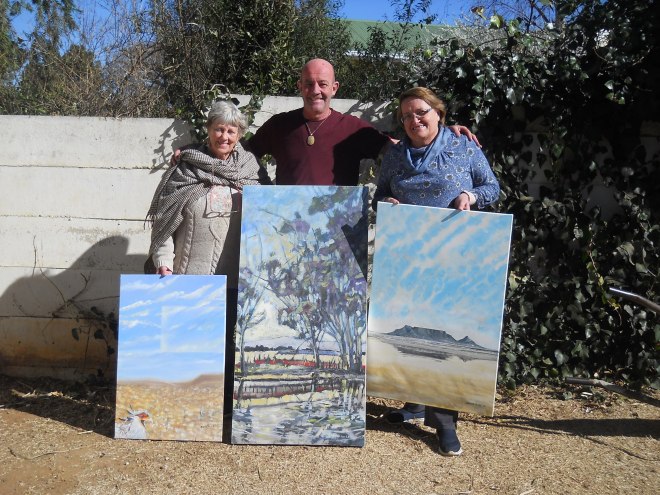
Susan and I started a little magazine for the West Coast called Out and About on the West Coast. This led to me travelling in South Africa to begin with and we began to take her four children on adventures. When I ventured into Botswana, Namibia and Zambia we produced guidebooks for the three countries. Susan taught herself graphic art and did all the advertisements that I sold. I did most of the travelling and selling but she joined me at times and we had exceptional times together. We marketed the books at the World Travel Fair in London, ITB in Berlin and at the convention centre in Durban.
Diz was instrumental in introducing me to Joy Bianchi. Joy was born on the Isle of Wight and arrived in Africa when she was seventeen. Her brother was working on the copper mines in Ndola in then Northern Rhodesia now Zambia. She married charming Con Bianchi, he with twinkling bedroom eyes and a great dancer. In next to no time she was living in the bush with four children! She had met Diz there when she too was on the copper belt with two children, Sue and Dori. There was a thriving horse community there.

I met Dori when she joined Diz in Philadelphia with her little daughter Jordan. Sue met her husband, a vet, there and the two immigrated to Australia where they have a chain of veterinary surgeries and two now grown up daughters.
Joy lived in a large old farmhouse in Gaborone. Her daughter Eileen had married an air force technician who had a terrible accident while on duty in Walvis Bay in Namibia. He became a paraplegic and Joy and Con dedicated their lives to helping the family and the two boys Glen and Ryan. Con built a riding stable for Eileen to teach riding and have an income. The boys became friends with Susan’s children especially when Susan moved to Maun in Botswana. Tragically Glen was electrocuted while working in a fuel from plants factory during his grandfather’s final days.
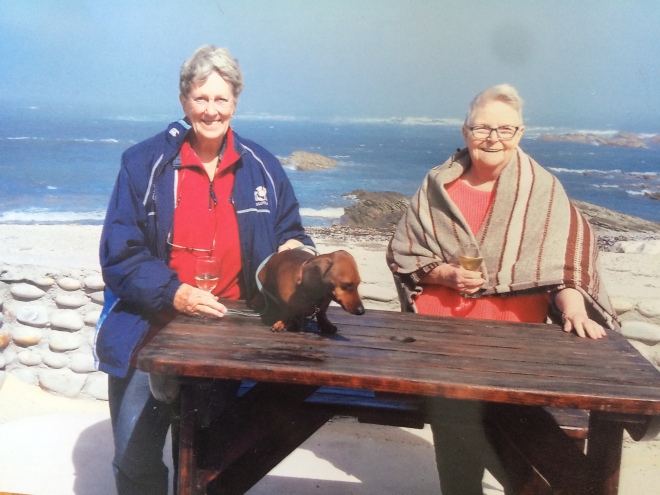
Tj had been working in London and let me know that he was returning overland. Could I meet him at Victoria Falls, Zimbabwe? I did and he greeted me. “My Mother I presume?” Tj was keen to go into the Okavango Delta and so was I. Accordingly we travelled to Maun where I met Tiaan Theron, one of the best guides in Botswana. Tiaan took us to the mokoro station in Moremi where we met our poler who took us into the delta.
The first night it rained cats and dogs. Lions roared! Elephants screamed. We shivered in our little tent but the next day the heat was back. Our poler turned out to be an excellent guide and one morning very early we crept up to within twenty feet of a feeding elephant. The poler kept testing the wind with his licked finger and after a few minutes we retreated. We were captivated by this wilderness and when Tiaan picked us up and joined us for a beer I asked him if he would take my grandchildren into the delta. “Provided they know I am boss and they listen to me!” Many adventures and years later we are still friends.
One year Tiaan phoned me and said he had a safari company for sale. Mick and I persuaded Susan who was then living with me in Langebaan during a difficult divorce to take up the offer. Mick put up the money and Susan and her kids lived in Maun for many a year.
Over the years whenever I went to Botswana I stayed with Joy and we had a very deep friendship. Joy was a top dressage judge in Gaborone so we had horses in common. However finances caught up with Joy during her retirement and she finally relocated to the UK. Her dog Thebe, a harlequin Great Dane, spent the rest of her life with Joy’s one son Ricky who lives in Kleinsee with Susan. Thebe has just recently died. Very sad, as she saved my life twice when under attack at Joy’s house outside Gaborone.
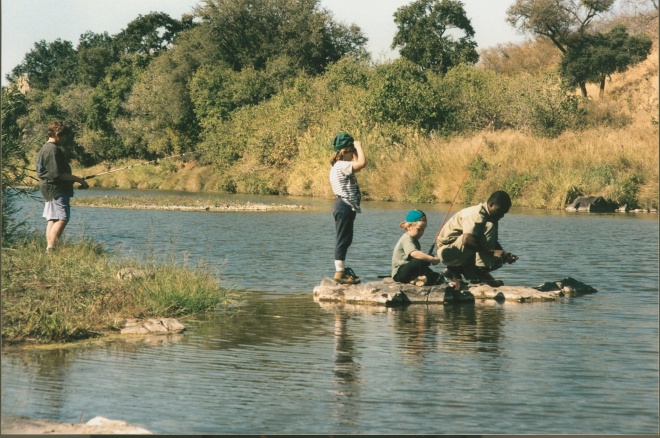
I cannot talk of Botswana without mentioning Norma Watson and her husband who owned Le Roo La Tau at the time. The name means the footsteps of the lion. We were always welcome there and Steve, their guide, took us on some very memorable safaris. Norma was a patron of the lovely Khama Reserve that is a sanctuary for breeding rhinos.
Eventually Susan and I were doing books for Namibia and Zambia as well. We first went into Zambia when a man in rags with an AK47 under a tree was the road block. How things have changed. Our books became so popular that we were ultimately hosted by top safari outfits such as Robin Pope Safaris and Shenton Safaris as well as Norman Carr Safaris.
Jenny came with me on a walking safari with Robin Pope safaris at Mupamadzi river in the remote north west of the park. One morning we came back very hot and Jenny told our guide that we were going to take a skinny dip in the shallow river. He obligingly cleared thee camp of staff and Jen and I wallowed with bums to the sky cooling off! Jo Pope told us that the other guests had so enjoyed our company that we were welcome any time. Susan I stayed at Nsefu on several occasions.
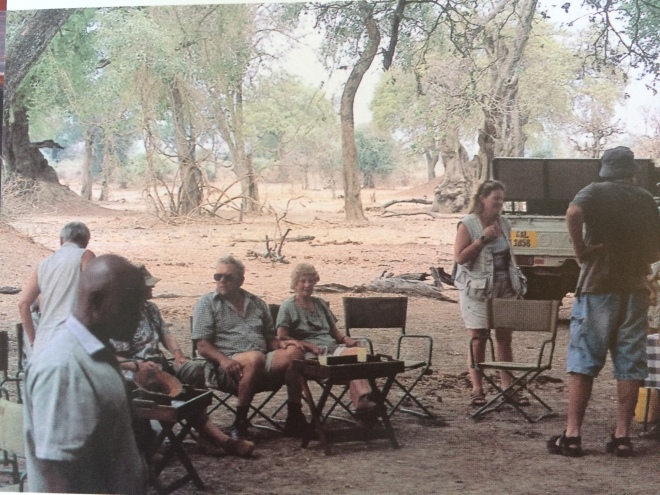
I stayed with Derek Shenton at Mwambo and Kaingo camp often. One night he took me on a night drive and we heard a peculiar mewing sound coming from a lioness. Sometime after I was in Kutze Reserve in Botswana, where there were very curious lions and I heard the same noise. We got into our vehicles immediately and sure enough the pride came walking through.
Time moved on and the road was a long one from Langebaan to Mozambique and Botswana. Mick had married Mandy and lived in Johannesburg as did TJ, married to Maud. Mick had one daughter with his first wife Marie, Meg currently working in London. Mandy had two girls who readily adopted me as a granny. Kate is an accountant and living here while her sister Sarah is living with her father in New Zealand. TJ and Maud were also living in Johannesburg and both Mick and I thought it would be better to move up here. Mick sold the Langebaan house and bought the cottage that I now have in a retirement village.
Joy and her one son live here as does her cousin Gail who has also been a friend for all the years I have known Joy. The other son lives in Cape Town and has a young son. She has recently met a life partner and they travel into Kruger National Park frequently also spending weekends away at the little known places around the country.
I have made new friends here, belong to Four Seasons Art studio under Sue Prior who has proved to be another friend. The other artists come from all walks of life and were very supportive during my time in hospital for the new hip replacement bringing me a marvelous hamper that also contained goodies for Jack my little dachshund.
I am travelling again. Just come back from Nelspruit and Kruger Park and will be off to see Susan in September where she lives at Kleinsee on the West coast then off to Mozambique for the Christmas holidays. Who knows where next? Probably Balito Bay near Durban for more art lessons from Denis. See him on the internet under Denis Lees and please check in to Four Seasons Studio as well. My adventures in these countries are often featured in the novels I write and the blogs I get out every two weeks or so.
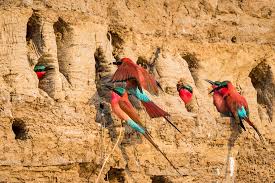 Returning to the lodge I had lunch and was approached by one of the waitresses. She asked me when I was due to leave. I replied that I would do so the next day. She then asked for a lift into Katimo Mulilo and promised to take me on a route that had firmer ground so that I would not get stuck. I willingly agreed.
Returning to the lodge I had lunch and was approached by one of the waitresses. She asked me when I was due to leave. I replied that I would do so the next day. She then asked for a lift into Katimo Mulilo and promised to take me on a route that had firmer ground so that I would not get stuck. I willingly agreed.